
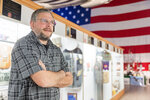
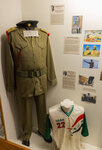
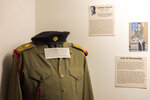
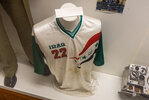
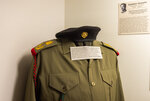
During World War II, it was common for soldiers to take helmets and uniforms from their defeated enemies.
By the late 20th century, taking war prizes was frowned upon and the U.S. military enacted regulations against the practice.
Therefore, the American soldier who brought one of just three known, authenticated Saddam Hussein uniforms back to the states will remain anonymous.
The outfit was taken during the fall of Baghdad in 2003 and sold in a 2005 auction through Manion’s, an international auction house that specializes in historical military items. According to Chip Duncan, executive director of the Veterans Memorial Museum in Chehalis, the anonymous soldier is said to have donated the profit to veteran charities.
On Veterans Day last weekend, more than 20 years after the dictator’s uniform was taken from Iraq, it was unveiled as a new, permanent exhibit in the Chehalis museum.
Duncan had the outfit examined by Craig Gottlieb, an antiquity expert who authenticates military items for the television show Pawn Stars.
“I’ve actually known Craig for many, many years, going back to military history websites and so on,” Duncan said. “He’s like, ‘Yep. That’s one of those. I’ve met with (Hussein’s) personal tailor.’ It had all these markers in the uniform, that he could say, ‘This is original.’”
Compared to the man who owned the outfit first, the anonymous American soldier’s crime is negligible. During his reign as president of Iraq from 1979 to 2003, Hussein was responsible for genocide, torture and many other crimes against humanity, as defined by the European Union.
Historians have estimated he was responsible for hundreds of thousands of deaths, against both enemies and his own people.
Beside Hussein's outfit in the museum is a second piece of clothing that illustrates the heinous nature of the dictator’s rule. A jersey worn by one, unnamed member of the Iraqi men’s Olympic soccer team has a faded but large blood stain.
Uday Hussein, one of Saddam’s two sons, was the head of the Olympic Committee in the Iraqi Football Association, Duncan said.
“Uday would torture soccer players if they lost a game,” he said, later adding, “His sons, Uday and Qusay, they were just some really sick individuals who enjoyed torturing people.”
Apparently, Duncan said, the sons were huge Star Wars fans and enjoyed torturing victims while wearing Darth Vader masks. Duncan said he tried to obtain one for the museum, but they cost a “pretty penny.”
Duncan has a concise way of describing Saddam, too: “A really bad individual.” Hussein was executed Dec. 30, 2006, after being captured by the U.S. military.
Describing the significance of having the outfit in Chehalis, Duncan recalled his perspective of the Iraq War, beginning when Hussein first lost control of Baghdad in 2003.
“Here I am, 19 years old,” Duncan recalled. “I’m like, ‘Oh man, I might get drafted.’ Those kinds of fears. And literally, you had Iraq throwing Scud missiles into Israel, hoping to provoke Israel into war. Which would have started World War III.”
Behind Duncan as he described the exhibit was an American flag massive enough to take up one whole wall of the Veterans Memorial Museum. That flag, he said, was on the U.S.S. Abraham Lincoln the day former President George W. Bush delivered his “Mission Accomplished” speech in May of 2003.
“Which is comical now,” Duncan said. “At the time, it was true. We had completely defeated the Iraqi army. … We just didn't anticipate an insurrection of such a large magnitude.”
Duncan thinks it is likely that several other of Hussein’s uniforms were brought to the states, but only three have been officially authenticated.
Another exhibit on display in the Veterans Memorial Museum of international significance is an outfit gifted by Saudi King Abdul Aziz Ibn Saud to veteran Lynn Hazen, whose family is from the Lewis County area, while the king met with former President Franklin D. Roosevelt.
Coming from a long line of veterans, Duncan’s passion, and the museum’s mission statement for veterans, is to ensure “they shall not be forgotten.” The museum also provides peer counseling, hosts community events, helps to connect local veterans with benefits and much more.
“This is what I can do for veterans behind the glass that aren't here to tell their stories anymore,” Duncan said. “But then there's all the veterans that stand where you and I stand, and that's also part of my passion.”
Learn more about the museum at https://www.veteransmuseum.org. Admission is free for active military members and costs $6 for students or children, $8 for seniors or veterans, $10 for adults and $20 for a family of four or more. It’s located at 100 SW Veterans Way, Chehalis.